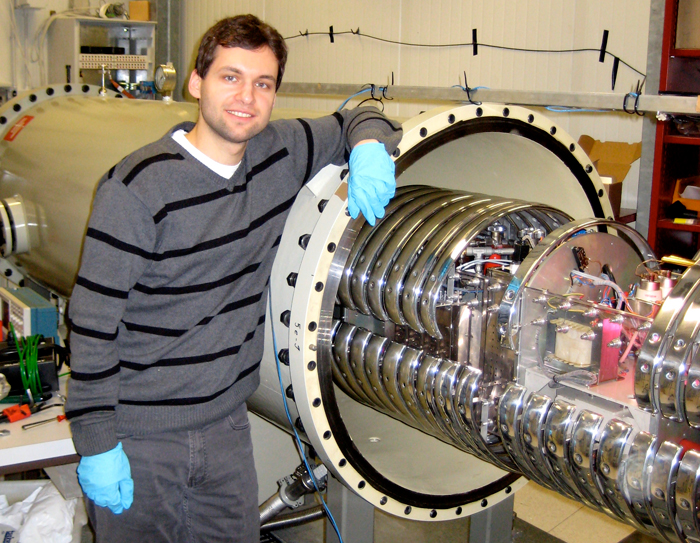HZDR’s Michael Anders at the LUNA accelerator in Gran Sasso, Italy. (Courtesy: HZDR/M Anders).
The only three elements created in the early universe, long before stars and galaxies began to form, were hydrogen, helium and lithium. According to Big Bang nucleosynthesis (BBN) theory, protons and neutrons combined to form these three elements just a few minutes after the Big Bang. While the theory does a good job of predicting the observed abundances of hydrogen and helium isotopes in the universe, it fails miserably when it comes to the two stable lithium isotopes: lithium-6 and lithium-7.
As far as lithium-7 is concerned, numerous observations suggest that there is much less of it in the universe than predicted with BBN, with the theory that underlies the prediction having been confirmed in 2006 by experiments done at LUNA by Daniel Bemmerer of Helmholtz-Zentrum Dresden-Rossendorf (HZDR) in Germany and colleagues. Now, Bemmerer and an international team of physicists have turned their attention to lithium-6, which accounts for about 7% of the lithium here on Earth.
Collisions between hydrogen and helium nuclei deep under a mountain in Italy have confirmed a mystery of cosmic proportions: why the amount of lithium-6 observed in today’s universe is so different from the amount that theory predicts was produced shortly after the Big Bang. Working at the Laboratory for Underground Nuclear Astrophysics (LUNA) at Gran Sasso, an international team of researchers has measured for the first time how fast lithium-6 is produced under conditions similar to those when the universe was a few minutes old. The measured rate suggests that almost all lithium-6 was actually produced well after the Big Bang – something that current theories of nucleosynthesis cannot explain.
The production of lithium-6 by BBN should be dominated by one nuclear reaction, namely the collision and subsequent fusion of deuterium (hydrogen-2) with helium-4 to create lithium-6 and a gamma ray. Bemmerer and colleagues have now used the 400 kV accelerator at LUNA to study this interaction at two collision energies that would have occurred in the early universe. They did this by firing an intense beam of helium-4 nuclei at a target of deuterium gas and monitoring the collisions for the gamma rays associated with the production of lithium-6. The probability that this specific fusion process occurs is very low, and so an important experimental challenge for the physicists was to see the weak gamma-ray signal among all the other radiation produced by the collisions, as well as background signals from naturally occurring radioactive materials and cosmic rays. By going deep underground, LUNA’s researchers were able to reduce the cosmic-ray background, while the effect of naturally occurring radon gas was minimized by flushing the experimental area with nitrogen gas.
After carefully analysing the gamma-ray spectra acquired during two experimental runs, the team calculated the rate at which lithium-6 is produced by fusion – finding it to be more or less as was expected. The team then used BBN to calculate the ratio of lithium-6 to lithium-7 that should have been present in the early universe. The result is of the same order of magnitude as previously calculated, albeit a bit smaller, which makes the observation of high levels of lithium-6 in metal-poor stars even more mysterious.
As for the origin of most of the lithium-6 in the universe, this latest measurement reinforces the argument that it could not have been forged in the early universe. One possibility is that the isotope is produced in stellar flares. A much more radical suggestion is that the excess of lithium-6 was created by hitherto unknown physical processes, making cosmic measurements of the isotope a potential probe of physics beyond the Standard Model of particle physics.
The research is reported in Physical Review Letters. http://journals.aps.org/prl/abstract/10.1103/PhysRevLett.113.042501
